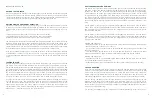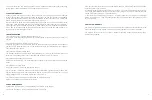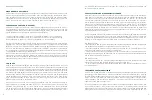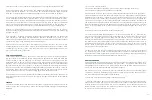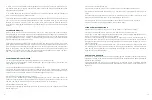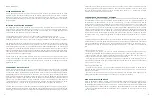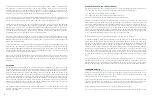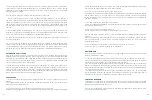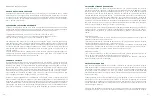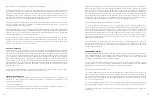
time “N” shots, and hold it down for long-exposure “B” shots. After you shoot, turn the Advance
Wheel
[6]
to get to the next frame.
When using the “B” setting for really long exposures – like nighttime or pinhole shots – you can
use the included Shutter Release Lock
[14]
to keep the shutter open. Press down on the Shutter
Release
[7]
and then place the Shutter Release Lock
[14]
right into the gap above the Release (a
hole will open up when you push the Release down.) When your exposure is done, just remove
the Lock
[14]
and let the Shutter Release
[7]
close. Remember to use a tripod and the Tripod
Thread
[15]
for the sharpest possible images!
Important – to avoid shaking or blurring your long-exposure image while using the Shutter Re
-
lease Lock
[14]
, be sure to place and remove it very carefully. Keep the camera as steady as
possible and move the Shutter Release
[7]
slowly and smoothly.
Even More Important – never change the Shutter Speed Switch
[8]
while the Shutter Release
[7]
is being held down. This could damage the mechanism. Only change the Shutter Speed Switch
[8]
when the release is closed. Be sure to mind this warning when using the Shutter Release Lock
[14]
– you’ve got to keep your fingers away from that speed setting!
Of course, you don’t have to advance the film after each shot. Feel free to fire the Shutter Re
-
lease
[7]
two times or more to create multiple exposure images. If it’s very sunny out, then don’t
shoot more than two exposures on the same frame, or your image will be very washed out.
UNLOADING
Unlike with 35mm cameras, there is no need to rewind 120 film. The entire roll will fully transfer
over to the Take-Up Spool
[3]
. Once you’ve passed your last shot (either shot 12 or shot 16,
depending on your format), you’ll need to keep winding until you feel the tension drop off com
-
pletely. You also won’t see anything behind the Film Format Switch’s
[4]
red window. Your film
is now totally wound onto the Take-Up Spool
[3]
and it’s safe to remove the Rear Door
[2]
. Take
out the finished film roll and seal it with the small paper tab on the end. Some brands have a
self-adhesive tab, and some require you to lick the tab. Either way, it’s a great time! The left side
of the camera now has an empty plastic spool there. Transfer that to the right side – as it will
become the Take-Up Spool for your next film roll.
Development should be done at a professional photo lab. If there isn’t one in your neighborhood,
then nose around on the Internet – there’s most likely a mailorder lab near you.
PINHOLE
Pinholes are a throwback to the earliest days of photography. Instead of a lens, you admit light
through a tiny hole. The resulting image has a few special characteristics:
1. A soft-focus, dreamy look
2. An extremely wide angle perspective with straight lines (no fisheye distortion)
3. Strange long-exposure daytime effects
As Pinholes are so small, they require a relatively long shutter time to admit enough light. With
ISO 400 film, you’ll need about 2 seconds in bright sunlight, 30 seconds in the shade, 6-15 min
-
utes in a lit indoor scene, and about 1-2 hours at night. Given these long exposure times, any
-
thing moving in front of the lens will be blurred. This can be very cool for daytime shots of people
walking, cars speeding by, dogs barking, etc. You’ll notice that shots taken indoors or at night
have stronger vignetting (darkening & blurring at the edges) then images shot in the sunlight. It’s
all part of the unpredictable fun of pinhole photography!
Your Diana+ has two different Pinhole settings:
1. True Pinhole: Set the Aperture to “P” and the Shutter to “B”. Grab a hold of the Forward Lens
Mount
[12]
, which is the part of the lens barrel that’s in front of the Shutter Speed Switch
[8]
and
Shutter Release
[7]
. Slowly and gently twist it counter-clockwise and remove the lens. You’re
now ready to shoot a traditional wide-angle pinhole shot. You can replace the lens by matching
up the Forward Lens Mount
[12]
with the four plastic posts behind it, and then rotating it clock
-
wise. The word “Diana” on the front of the lens will be at the 10 o’clock position when you match
them up, and then rotate to its correct 12 o’clock position when the lens is re-attached.
2. Magnum Pinhole: Like before, set the Aperture to “P” and the Shutter to “B.” But this time,
leave the lens on. The result is a slightly sharper pinhole image with the usual focal distance of a
Diana+ shot. This is great for capturing those super-long-exposure effects without the extreme
wide-angle perspective.
ENDLESS PANORAMA
Stitching together a panoramic image is one of the most awesome techniques in analog pho
-
tography. Often, the panoramic ends up a little bit “off” – giving it a really unique and interesting
look. With the Diana+, you can easily create panoramic shots that are as long and as all-encom
-
passing as you like.
As you learned in the first section, you’ll need to insert the Panoramic frame mask and set the
Film Format Switch
[4]
to “16.” With these settings, there will be almost no gap between each
image, thereby giving you a (more or less) seamless panoramic image.
And here’s four tips for your Panoramic success:
1. If you want to ensure no overlapping between frames, then advance a little more than the
next exposure number each time. For example, Fuji films have a series of dots in-between the
exposure numbers. These countdown your advancing until the next number comes up. After you
shoot “1,” advance to the first dot after the number “2.” Then advance to the second dot after
number “3.” And so on.
2. If you’re shooting a panoramic landscape and you want to get as little repetition between
frames as possible, then turn your camera about 45 degrees after each shot. Or turn it a lot less
– and savor that sweet multiple-exposure-panorama effect!
3. Use a tripod on level ground to keep your individual panoramic frames on [more or less] the
same plane.
4. Of course you can throw caution to the wind. Shoot panoramas on the 12 shot format. Ad
-
vance a full frame once, then a half frame, then a whatever-the-hell frame. Shoot multiple times
4
5
Содержание DIANA+
Страница 1: ......
Страница 18: ...32 33 ...
Страница 19: ...34 35 ...
Страница 20: ...36 37 ...
Страница 21: ...38 39 ...
Страница 22: ...40 41 ...
Страница 23: ...42 43 ...
Страница 24: ...44 45 ...
Страница 25: ...46 47 ...



